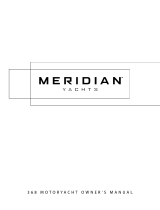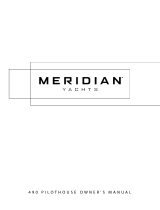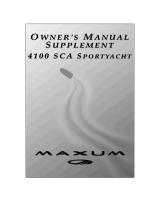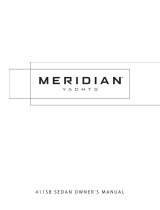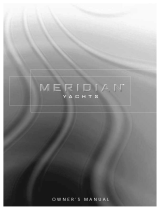Page is loading ...



Port Engine Serial Number:
Stbd. Engine Serial Number:
Hull Identification Number:
Hull Identification Number
The Hull Identification Number (HIN) is located on the starboard side of the transom. Be sure to record the HIN (and
the engine serial numbers) in the space provided above. Please refer to the HIN for any correspondence or orders.
© 2001-2002 Bayliner Technical Publications. All rights reserved.
No part of this publication may be reproduced, stored in any retrieval system, or transmitted in any form by any means, electronic,
mechanical, photocopying, recording or otherwise, without prior written permission of Bayliner.
Printed in the United States of America.
General Notes
The material in this document is for information only and is subject to change without notice. While reasonable efforts have been made in
the preparation of this document to assure its accuracy, Bayliner assumes no liability resulting from errors or omissions in this document,
or from the use of information contained herein.
Due to our commitment to product improvement, Bayliner reserves the right to make changes in the product design, specifica-
tions, and equipment at any time without notice or obligation. Illustrations and/or photos may show optional equipment.
All Bayliner products meet or exceed USCG (Unites States Coast Guard) and/or NMMA (National Marine Manufacturer’s Association)
construction standards. Manufactured with 1,1,1 Trichloroethane, a substance which harms public health and environment during the
manufacturing process by destroying ozone in the upper atmosphere.
Proprietary Rights
This document discloses subject matter in which Bayliner has proprietary rights. The information and design disclosed herein were origi-
nated by and are the property of Bayliner. Neither receipt nor possession thereof confers or transfers any right to reproduce, copy, alter or
disclose the document or any part thereof, any information contained therein, or to construct boats or any item from it, except by written
permission from or written agreement with Bayliner. This document is to be returned upon request to Bayliner.
HIN LOCATION

CONTENTS
CHAPTER 1: ABOUT THIS MANUAL
1 Dealer Service
1 Boating Experience
1 Engines/Accessories Guidelines
1 Qualified Maintenance
2 Structural Limitations
2 Special Care For Moored Boats
2 Sacrificial Anodes (Zincs)
3 Carbon Monoxide (CO)
3 Sources of CO
4 Carbon Monoxide Alarm System
4 What To Do If Carbon Monoxide Is Detected
4 Safety Standards
5 Hazard Warning Symbols
CHAPTER 2: FEATURES / SYSTEMS
6 Layout View
7 Lifting Sling
8 Hull Exterior Hardware
9 Deck Equipment
9 Deck Fill & Pump-out Locations
9 Windshield Wipers
9 Anchor Windlass
10 Instruments
10 Helm Layout
11 Navigation & Communication Equipment
11 Depth Finder
11 Compass
11 Autopilot (Option)
11 VHF Radio
12 Lights
12 Navigation & Interior Lights
12 Spotlight
12 Dockside Television & Telephone Inlet
12 Audio & Visual Equipment
13 Appliances
13 Propane System (Option)
14 Engines
14 Engine Cooling System
14 Exhaust System
15 Engine Room Ventilation System
15 Shaft-Transmission Alignment
15 Shaft Log Packless Sealing System
16 Fuel System
16 Fuel Fills & Vents
17 Fuel Transfer Pump (Option)
17 Fuel Filters & Separators
17 Fuel Quality
17 Oil Change System (Option)
17 Fire Extinguishing System (Option)
18 Controls
18 Steering & Shift/Throttle System
18 Trim Tabs
19 ICE-Integrated Control System (Option)
20 Bilge Pump Systems
20 Autofloat Switches
21 Bilge Pump Locations
22 Freshwater System
23 Water Heater
24 Hot & Cold Water Routing
25 Gray Water Drain System
26 Seawater Systems
26 Seawater Strainers
26 Seawater Washdown (Option)
27 Air Conditioner & Heater (Option)
27 Air Conditioning Pickup Routing:
28 Air Conditioning Control Panel Locations:
28 Electric Heaters (Option)
28 Heat Exchanger Cabin Heater (Option)
29 Marine Head System with Holding Tank
29 Waste System Routing (Electric Option)
30 Waste System Routing (Vacuflush Option)
30 Vacuum System (Option)
31 Electrical System
32 12-Volt DC System
32 Fuses and Circuit Breakers
32 Battery Switches
32 Batteries
33 Engine Alternators
33 Battery Charger
33 AC Electrical System
34 Shore Power
34 Connecting To Shore Power
35 Inverter Power (Option)
36 Generator Power (Option)

APPENDIX A: ELECTRICAL ROUTINGS
38 Deck Harness Port
38 Deck Harness Starboard
39 Windlass Harness
39 Bonding Harness Routing
40 Forward Bilge Harness Routing
40 Forward Bilge Harness Routing
APPENDIX B: WIRING SCHEMATICS
41 Engine and Helm Control Wiring Diagram
42 DC-Distribution System-Command Bridge Wiring Diagram
43 DC-Distribution System-Pilot House Wiring Diagram
44 DC-Auxiliaries and Battery Wiring Diagram
45 120-Volt AC Wiring Diagram
APPENDIX C: EXPRESS LIMITED WARRANTY


3488 Motoryacht • Owner’s Manual Supplement
1
CHAPTER 1: ABOUT THIS MANUAL
This Owner’s Manual Supplement was prepared to provide specific information about your yacht. Please study this
supplement and the Owner’s Manual carefully, paying particular attention to Appendix C: LIMITED WARRANTY.
Keep this supplement on your yacht in a secure, accessible place.
Dealer Service
Make certain that you receive a full explanation of all systems from the selling dealer before taking delivery of your
yacht. Your selling dealer is your key to service. If you experience any problems with your new yacht, immediately
contact the selling dealer. If for any reason your selling dealer is unable to help, you can call us direct on our cus-
tomer service hotline: 360-435-8957 or send us a FAX: 360-403-4235.A Bayliner replacement parts catalog is avail-
able online at: http://www.baylinerparts.com. Replacement parts can be purchased from any authorized
Bayliner dealer.
Boating Experience
If this is your first boat or if you are changing to a type of boat you are not familiar with, for your own comfort and
safety, please ensure that you obtain handling and operating experience before assuming command of the yacht.
Take one of the boating safety classes offered by the U.S. Power Squadrons or the U.S. Coast Guard Auxiliary. For
more course information, including dates and locations of upcoming classes, contact the organizations directly:
• U.S. Power Squadrons: 1-888-FOR-USPS (1-888-367-8777) or on the Internet at: http://www.usps.org
• U.S. Coast Guard Auxiliary: 1-800-368-5647 or on the Internet at: http://www.cgaux.org
Outside the United States, your selling dealer, national sailing federation or local yacht club can advise you of local
sea schools or competent instructors.
Engines/Accessories Guidelines
Your yacht’s engines and accessories were selected to provide optimum performance and service. Installing different
engines or other accessories may cause unwanted handling characteristics. Should you choose to install different
engines or to add accessories that will affect the boat’s running trim, have an experienced marine technician perform
a safety inspection and handling test before operating your yacht again.
The engines and accessories installed on your yacht come with their own operation and maintenance manuals. Read
and understand these manuals before operating the engines/accessories.
Qualified Maintenance
Failure to maintain your yacht’s systems (listed in the warning above) as designed could violate the laws in your
jurisdiction and could expose you and other people to the danger of bodily injury or accidental death. We recommend
that you follow the instructions provided in this supplement, the Owner’s Manual, the engine owner’s manual and the
accessory instruction sheets included with your boat.
CONTROL HAZARD! A qualified operator must be in control of the yacht at all times. Do not
operate your yacht while under the influence of alcohol or drugs.
WARNING!
!
To maintain the integrity and safety of your yacht, only qualified personnel should perform
maintenance on, or in any way modify: The steering system, propulsion system, engine control
system, fuel system, environmental control system, electrical system or navigational system.
WARNING!
!

2 CHAPTER 1: ABOUT THIS MANUAL
3488 Motoryacht • Owner’s Manual Supplement
Structural Limitations
The command bridge, transom platform and bow platform are designed to be lightweight for proper boat balance.
The load limit for these platforms and the command bridge is 30 pounds per square foot, evenly distributed.
Special Care For Moored Boats
If moored in saltwater or fresh water, your boat will collect marine growth on its hull bottom. This will detract from
the boat’s beauty, greatly affect its performance and may damage the gelcoat. There are two methods of slowing
marine growth:
• Periodically haul the boat out of the water and scrub the hull bottom with a bristle brush and a solution of soap
and water.
• The hull below the waterline was painted with anti-fouling paint by the factory. Occasionally you will need to re-
paint it with a good grade of anti-fouling paint.
Sacrificial Anodes (Zincs)
Your yacht is equipped with sacrificial anodes to protect underwater metal parts from excessive deterioration. Sacri-
ficial anodes should be checked regularly and replaced if they have deteriorated more than 70%. There are many fac-
tors that determine the rate at which sacrificial anodes deteriorate, including:
• Water temperature
• Salinity
• Water pollution
Stray current from the boat or dock may cause complete deterioration in just a few weeks. If there is rapid anode
deterioration, measure electrolytic corrosion around your yacht with a corrosion test meter. If sacrificial anodes are
not bonded correctly, they will not provide protection.
.
NOTICE
• To help seal the hull bottom and reduce the chance of gelcoat blistering on moored boats, we
recommend the application of an epoxy barrier coating, such as INTERLUX, Interprotect
2000E/2001E. The barrier coating should be covered with several coats of anti-fouling paint.
• Many states regulate the chemical content of bottom paints in order to meet environmental
standards. Check with your local dealer about recommended bottom paints, and about the
laws in effect in your area.
NEW SACRIFICIAL ANODE DETERIORATED SACRIFICIAL ANODE
Do not paint between the zinc and the metal surface it contacts and do not paint over the zincs.
NOTICE

CHAPTER 1: ABOUT THIS MANUAL 3
3488 Motoryacht • Owner’s Manual Supplement
Carbon Monoxide (CO)
CO poisoning causes a significant number of boating deaths each year. Called the "silent killer", CO is an extremely
toxic, colorless, odorless and tasteless gas. Breathing CO blocks the ability of your blood to carry oxygen. The effects
are cumulative, even low levels of exposure can result in injury or death. Factors increasing the effects of CO
include: age, smokers or people exposed to high concentrations of cigarette smoke, consumption of alcohol, lung dis-
orders, heart problems, and pregnancy.
Sources of CO
Sources of CO include:
To correct stationary situations a and/or b:
• Close all windows, portlights and hatches.
• If possible, move your boat away from the source of the CO.
To correct running situations c and/or d:
• Trim the bow down.
• Open windows and canvas.
• When possible, run the boat so that the prevailing winds will help dissipate the exhaust.
IMMEDIATELY take corrective action if CO is detected (see, Carbon Monoxide Alarm System, on the next page).
DANGER
CARBON MONOXIDE POISONING HAZARD! Carbon monoxide gas (CO) is color-
less, odorless, and extremely dangerous. All engines, generators, and fuel burning
appliances produce CO as exhaust. Direct and prolonged exposure to CO will cause
BRAIN DAMAGE or DEATH. Signs of CO poisoning include headache, nausea,
dizziness, and drowsiness.
DANGER!
!
c. Running the
boat with the
trim angle of the
bow too high.
b. Mooring close to
another boat that
is using its engine,
generator or any
other CO source.
a. Using the engine
or the generator
when the boat is
moored in a con-
fined space.
d. Running the boat
without through
ventilation (station
wagon effect).

4 CHAPTER 1: ABOUT THIS MANUAL
3488 Motoryacht • Owner’s Manual Supplement
Carbon Monoxide Alarm System
Your boat may feature a carbon monoxide (CO) alarm system. DO
NOT DISCONNECT THE ALARM SYSTEM. Read and understand
the manufacturer’s instructions for your CO alarm system. If you did
not receive an instruction manual, call (800) 383-0269 and one will be
mailed to you. If your yacht is not equipped with a carbon monoxide
alarm, consider purchasing one from your dealer or marine supply store.
What To Do If Carbon Monoxide Is Detected
• Immediately ventilate and evacuate any enclosed spaces that are
occupied by people and reset your CO alarm.
• Immediately move anyone showing any symptoms of CO poisoning
into fresh air. See a doctor if any symptoms persist. If the person is
unconscious, immediately administer oxygen or CPR and call for
emergency help.
Safety Standards
Your yacht’s mechanical and electrical systems were designed to meet safety standards in effect at the time it was
built. Some of these standards were mandated by law; all of them were designed to insure your safety, and the safety
of other people, vessels and property.
Read the Owner’s Manual and all accessory manuals for important safety standards and hazard information.
MARINE TECHNOLOGIES INC.
CARBON MONOXIDE ALARM - MODEL 60-541
(REPLACE AFTER TEN YEARS OF USE)
DANGER
PERSONAL SAFETY HAZARD! Do not allow anyone to ride on parts of the yacht
not designated for such use. Sitting on seat backs, lounging on the forward deck,
bow riding, gunwale riding or occupying the transom platform while underway
is especially hazardous and will cause personal injury or death.
DANGER!
!
DANGER
PERSONAL SAFETY HAZARD! Always secure the anchor and other loose objects before getting
underway. The anchor and other items that are not properly secured can come loose when the
boat is moving and cause personal injury or death.
DANGER!
!

CHAPTER 1: ABOUT THIS MANUAL 5
3488 Motoryacht • Owner’s Manual Supplement
Hazard Warning Symbols
The hazard warning symbols shown below are used throughout this Supplement to call attention to potentially dan-
gerous situations which could lead to either personal injury or product damage. We urge you to read these warnings
and the ISO symbols listed in
Appendix B
carefully. Follow all safety recommendations.
DANGER!
!
This symbol alerts you to immediate hazards which
WILL
cause severe personal injury or
death if the warning is ignored.
WARNING!
This symbol alerts you to hazards or unsafe practices which
COULD
result in severe personal
injury or death if the warning is ignored.
!
CAUTION!
This symbol alerts you to hazards or unsafe practices which
COULD
result in minor personal
injury or cause product or property damage if the warning is ignored.
!
NOTICE
This symbol calls attention to installation, operation or maintenance information, which is
important to proper operation but is not hazard-related.
EXPLOSION
HAZARD!
OPEN FLAME
HAZARD!
HOT
HAZARD!
ROTATING
PROPELLER HAZARD!
PERSONAL INJURY
& FALLING HAZARD!
ELECTRICAL
HAZARD!
CO POISONING
HAZARD!

3488 Motoryacht • Owner’s Manual Supplement
6
CHAPTER 2: FEATURES / SYSTEMS
Layout View
Overall
Length
Bridge
Clearance
Beam Draft
Fuel Tank
Capacity (gal)
Water Tank
Capacity (gal)
Holding Tank
Capacity (gal)
35' 0" 14' 1" 11' 8" 3' 2" 224 92 30
Lower Helm Option

CHAPTER 2: FEATURES / SYSTEMS 7
3488 Motoryacht • Owner’s Manual Supplement
Lifting Sling
LABELS
NOTE:
Lifting sling posi-
tions shown here are typical
for port and starboard sides.
142"
49"
PRODUCT OR PROPERTY DAMAGE HAZARD!
• When lifting any boat always use a spreader bar. The spreader bar must be equal to the
width of the boat at the lifting point.
• Secure the slings to one another to prevent the forward sling from sliding up along the fore-
foot of the yacht.
CAUTION!
!

8 CHAPTER 2: FEATURES / SYSTEMS
3488 Motoryacht • Owner’s Manual Supplement
Hull Exterior Hardware
PORT HULLSIDE
COMMAND
EXHAUST
PORTLIGHTS
AIR/COND
LOCKER
STARBOARD HULLSIDE
FWD BILGE
GALLEY SINK
DRAIN
HEAD SINK
MARINE HEAD
HOLDING TANK VENT
WATER TANK
VENT
FUEL TANK
VENT
AFT
BILGE
AIR/COND GENERATOR
DRAIN
PUMPS
EXHAUST
SACRIFICIAL
TRIM TAB RUDDER
ZINC ANODE
CITY WATER
INLET
BOARDING
SHOWER
SUMP PUMP
HOT WATER
TANK DRAIN EXHAUST
COCKPIT
DRAIN BRIDGE
DRAIN
DRAIN
OUTLET
DISCHARGE
FWD/MID
BILGE PUMPS
PUMPS OVERBOARDS
OVERBOARDS
DISCHARGE
(OPTION)
AIR/COND
PAN DRAIN
(OPTION) (OPTION)
OUTLET
STERN
THRUSTER
BOW
THRUSTER
(OPTION)
COMMAND
BRIDGE
DRAIN
COCKPIT
DRAIN
FUEL TANK
VENT
AFT/MID
BILGE PUMP
OVERBOARD
PLATE
TRANSOM
LADDER

CHAPTER 2: FEATURES / SYSTEMS 9
3488 Motoryacht • Owner’s Manual Supplement
Deck Equipment
Deck Fill & Pump-out Locations
Windshield Wipers
• Wiper blades must be replaced when they become worn or deteriorate due to weathering. Replace wiper
blades using 28” blade refills. Instructions for replacing the wiper blades can usually be found on the blade
replacement package.
Anchor Windlass
Before using the anchor windlass, read the
windlass manual included in your yacht’s
owner’s packet and observe the following:
• To haul the anchor, use engine power (not
the windlass) to move the boat to, and
directly over the anchor.
• Disengage the anchor from the bottom by
pulling it straight up with the windlass. Do
not pull the boat to the anchor using the
windlass or continue to operate the anchor
windlass if it stalls or is overloaded.
FUEL FILL
FRESH
NOTE: Waste tank dock-
side pump out (not shown)
is located on the port side
of the deck.
FITTINGS
WATER FILL
Windlass controls are
located on the foredeck,
next to the windlass, and
at the upper helm station.
ANCHOR
WINDLASS
WINDLASS
CONTROLS
FOREDECK
ANCHOR
LOCKER

10 CHAPTER 2: FEATURES / SYSTEMS
3488 Motoryacht • Owner’s Manual Supplement
Instruments
Helm Layout
COMPASS
OIL PRESSURE
TEMPERATURE
VOLTAGE GAUGE
FUEL GAUGE
TACHOMETER
GAUGE
GAUGE
SPOTLIGHT
SHIFTER/THROTTLE
ENGINE SYNCHRONIZER GAUGE
CONTROLS
(OPTION)
ENGINE HOUR METER
VHF RADIO HANDSET CONNECTION
(OPTION)
NAVIGATION
INSTRUMENTS
(OPTIONS)
12 345 67 938922
1
2
3
4
5
6
8
9
10
LOWER HELM (OPTION)
11
12
10
14 CROSSOVER (PARALLEL) SWITCH
8
13
14
15
LOWER HELM ONLY (OPTION)
11 12 13
11
14
1512 15 15
10
NOTE: helm switch panels may contain
inactive switches for control of accesso-
ries that are not installed on your yacht.
WINDSHIELD WIPER
HORN
BILGE PUMP
ANCHOR WINDLASS
FUEL TRANSFER PUMP (OPTION)
AUTO PILOT (OPTION)
FUEL GAUGE POWER SWITCH
EMERGENCY BATTERY
BILGE BLOWERS
ENGINE CONTROLS
TRIM TAB SWITCHES
ACCESSORY (NOT USED)
NAVIGATION LIGHTS
LIGHT
7 DEPTH FINDER

CHAPTER 2: FEATURES / SYSTEMS 11
3488 Motoryacht • Owner’s Manual Supplement
Navigation & Communication Equipment
The owner’s packet contains operation manuals for all navigation & communication equipment installed on your
yacht. Thoroughly read and understand these manuals before using these systems for the first time and observe
the following:
Depth Finder
Your motoryacht features a depth finder (depth sounder) at the helm station. The depth finder provides you with mea-
surements of water depth beneath the boat.
Compass
Your yacht is equipped with a compass at the helm station. Carefully read and follow the manufacturer’s calibration
and operating instructions provided in the boat’s owner’s packet.
Autopilot (Option)
Your yacht may feature an optional autopilot system which can be turned on at the upper helm station. The autopilot
will aid you in maintaining the chosen heading of your yacht.
VHF Radio
Your yacht may include an VHF (Very High Frequency) radio. The VHF radio can be used to access weather reports,
summon assistance or contact other vessels as permitted by the FCC (Federal Communications Commission). Con-
tact the FCC for licensing, rules and regulations concerning VHF radio usage.
• Do not use the depth finder as a navigational aid to prevent collision, grounding, boat dam-
age or personal injury.
• When the boat is moving, submerged objects will not be seen until they are already under
the boat. Bottom depths may change too quickly to allow time for the boat operator to react.
If you suspect shallow water or submerged objects, operate the boat at very slow speeds.
WARNING!
!
NOTICE
Compass accuracy can be affected by many factors. Have a qualified technician calibrate your
compass. Make sure the technician gives you a deviation card which shows the corrections to
apply in navigational calculations. Keep a copy of the deviation card at each helm.
Never leave the helm while the autopilot system is on! A qualified operator must monitor the
autopilot system at all times and keep lookout for other marine traffic and other hazards.
WARNING!
!
NOTICE
Τhe autopilot system is only an aid to navigation. It's accuracy can be affected by many factors,
including equipment failure or defects, environmental conditions & improper handling or use.

12 CHAPTER 2: FEATURES / SYSTEMS
3488 Motoryacht • Owner’s Manual Supplement
Lights
Navigation & Interior Lights
Read the navigation section of the Owner’s Manual and make sure that you understand navigation light usage. The
navigation and interior lights supplied with your yacht are of top quality, but you should be aware that failure may
sometimes occur for a variety of reasons:
• There may be a tripped circuit breaker. (Check the push-to-reset breakers at the upper helm).
• The bulb may be burned out (Carry spare bulbs for replacement).
• The bulb base may be corroded (Clean the base and coat it with non-conductive electrical lubricant).
• A wire may be damaged or may have come loose (Repair as required).
Spotlight
Your yacht is equipped with a spotlight on the command bridge of your yacht and can be controlled from the upper
helm station. Read the operating instructions included in your yacht’s owner’s packet.
Dockside Television & Telephone Inlet
Your yacht is equipped with a
dockside cable TV (television)
and telephone inlet.
• The TV/telephone dockside
inlet is located in the transom
storage locker next to the
shore power inlets.
• To use a telephone or receive
cable TV transmission, the
yacht must be hooked up to a
dockside source using the
TV/telephone inlet.
Audio & Visual Equipment
All audio and visual equipment installed on your yacht have separate manuals explaining their operating instructions.
• Avoid the storage of gear where it would block navigation lights from view.
• Prolonged use of cabin interior lights (overnight) will result in a drained battery. Be conser-
vative in the use of battery power.
CAUTION!
!
DOCKSIDE CABLE
TV & TELEPHONE
INLET LOCATION
NOTICE
AM radio reception may be impaired anytime the engines are running.

CHAPTER 2: FEATURES / SYSTEMS 13
3488 Motoryacht • Owner’s Manual Supplement
Appliances
The owner’s packet includes operating and maintenance manuals for all appliances installed in your yacht. Carefully
read and understand these manuals before attempting to operate or perform maintenance on any appliance.
Appliances operate on 120v AC power, which may be supplied from shore power, optional generator power or
optional inverter power. There may not be sufficient generator or inverter power to operate all AC appliances at the
same time. Make sure the AC breaker is turned on for the appliance you wish to use.
Propane System
Your yacht may feature a propane system. Read the propane stove operating instructions included in your yacht’s
owner’s packet.
BURN HAZARD!
• Do not touch stove burners, grates or areas near the stove units as they may be hot even
when they are dark in color. Areas near burners and grates may become hot enough to
cause burns.
• During and after use, do not touch or let clothing or other flammable material come in con-
tact with heated units or areas near the units (burner tops, main frame sides and back, sea
rails and pot holders) until they have had sufficient time to cool.
WARNING!
!
PROPANE TANK
LOCATION
p
s
i
1
SOLENOID
STOVE AND PROPANE
CONTROLS
PROPANE
CONTROLS
DANGER!
!
CARBON MONOXIDE POISONING HAZARD!
The propane stove is a potential source of dangerous carbon monoxide gas (CO). Do
not operate without adequate ventilation.

14 CHAPTER 2: FEATURES / SYSTEMS
3488 Motoryacht • Owner’s Manual Supplement
Engines
The owner’s packet contains detailed engine operation and maintenance manuals. Read and understand these manu-
als before using or working on the engines.
Engine Cooling System
The engine cooling system circulates raw water around com-
ponents and also uses a freshwater heat exchanger on the
engine to reduce engine temperature.
• Make sure both engine seawater intake valves (seacocks)
are open before starting the engines and keep the seacocks
open while the engines are running.
• The cooling system’s seawater strainers should be checked
for leaks and debris every time you use your yacht. For
instructions on how to clean the seawater strainers, see the
Seawater System section of this Supplement.
Exhaust System
The exhaust system is designed to keep water out of the engines in most sea conditions, however, do not anchor the
stern to sea or shut the engines off if high seas might flood the exhaust system. Always consider the sea conditions
before anchoring or shutting off the engines.
CONNECT TO
RAW WATER PUMP
INLET ON ENGINES
ENGINE COOLING SYSTEM ROUTING (TYPICAL)
SEAWATER
STRAINERS
SEACOCK GASKET
SEACOCK (TYPICAL)
SEACOCK
LEVER
ENLARGED VIEW OF ENGINE SEAWATER INTAKE VALVE
INTAKE
STRAINER
CAUTION!
SYSTEM DAMAGE HAZARD! The engine cooling
system’s seacocks must be opened before engines are
started and during engine operation.
!
DANGER!
!
CARBON MONOXIDE POISONING HAZARD!
Leaking engine and/or generator exhaust is a source of dangerous carbon monoxide
gas (CO). Check all exhaust systems before each trip.
• Look for leaks in exhaust systems of both generator and propulsion engine(s).
• Look for discoloration, water leaks, carbon or stains around joints.
• Make sure all exhaust clamps are in place and secured.
• Make sure ventilation systems work and are not obstructed or restricted.
• Make sure gaps around engine room plumbing, cableways, exhaust system, doors, hatches,
and access panels are minimized to reduce the chance of CO entering the living space(s).
EXHAUST SYSTEM LAYOUTS
DIESEL ENGINE EXHAUST SYSTEM
MUFFLERS
EXHAUST THRU-HULLS
(TYPICAL PORT & STBD)
EXHAUST HOSES (TYPICAL)
GAS ENGINE EXHAUST SYSTEM
/
